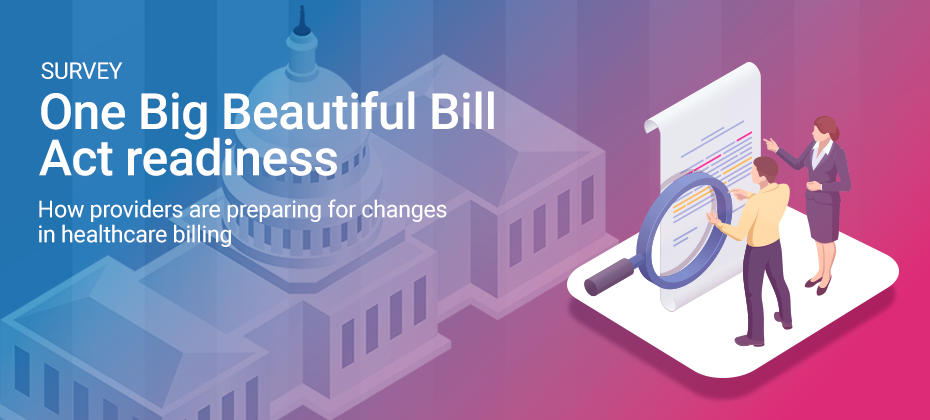Tag: Medicare

Revenue cycle management (RCM) teams are facing a year of major change, with new regulations, tighter margins and the adoption of artificial intelligence (AI) increasing the pressure on workflows. This article outlines Experian Health’s five RCM predictions for 2026, along with tools to consider when building a resilient revenue cycle.

Hospitals that treat Medicaid patients should update their eligibility and billing systems now to prepare for the One Big Beautiful Bill Act (OBBBA), which will bring major changes to Medicaid.

As the healthcare industry prepares for the implementation of the One Big Beautiful Bill Act (OBBBA), it’s clear that readiness is not one-size-fits-all. Hospitals are leading the way, but most providers will need focused updates to their Medicaid/Medicare processes to ensure compliance and protect revenue. In October 2025, Experian Health surveyed 200 healthcare decision-makers to get a better understanding of their readiness levels, where they’ll be impacted and what they’re focusing on, following implementation of the OBBBA. Here are the results: To prepare for incoming changes from the OBBBA, revenue cycle leaders will need to accelerate their adoption of artificial intelligence (AI) and automated solutions. AI-powered tools, like Patient Access Curator, can help providers streamline insurance eligibility checks and improve claims accuracy. Other tools, like Patient Financial Clearance, can help providers support their patients, and minimize risks from uncompensated care. Find out how Experian Health's revenue cycle management solutions can help your healthcare organization navigate upcoming regulatory shifts and changes. Learn more Contact us

Propensity-to-pay models forecast which patients are likely to pay their bills, enabling smarter prioritization. By using data-driven automation, these tools help healthcare providers boost collections, reduce bad debt and improve overall revenue cycle efficiency.

Over the past two decades, U.S. hospitals have absorbed nearly $745 billion in uncompensated care, according to the American Hospital Association. This burden continues to grow as hospitals struggle to verify active insurance. The task is made harder by patients frequently changing jobs, relocating and moving through a fragmented payer system that providers must track and interpret. The result? Missed billing opportunities, delayed payments and unnecessary write-offs threaten not only the hospital's financial stability, but also their ability to provide care to their communities. Now, the newly enacted "One Big Beautiful Bill Act" adds even more pressure. With sweeping Medicaid cuts and stricter eligibility rules, millions of Americans could lose coverage — and hospitals may face a sharp rise in uncompensated care. Key provisions include: More frequent eligibility reviews (every six months instead of annually) Higher out-of-pocket costs (up to $35 per doctor visit) New limits on state Medicaid funding (including bans on provider taxes) According to the Congressional Budget Office, an estimated 11.8 million people could lose Medicaid coverage by 2034. These changes shift more financial responsibility to hospitals and patients. But the impact isn't just financial. For patients, undetected coverage can lead to surprise bills, postponed treatment, or even collections, all of which erode trust in the healthcare system. Vulnerable populations, particularly those affected by the latest Medicaid changes, are at the greatest risk of falling through the cracks. Hospitals are committed to serving their communities, including those who may not be able to afford to pay. To do this, they must recover every dollar they're entitled to. That means identifying coverage wherever it exists, even when it’s hidden, forgotten or misclassified. That’s where Coverage Discovery comes in. Experian Health's solution uses proprietary data and advanced machine learning to identify unknown or forgotten insurance coverage across the entire revenue cycle — before, during, and after care. Unlike traditional eligibility checks, Coverage Discovery goes deeper. It scans commercial, government and third-party payers in real time; it uncovers primary, secondary and even tertiary coverage that might otherwise go unnoticed. This proactive approach helps providers bill the right payer the first time, which reduces denials, accelerates reimbursements, and minimizes bad debt. Coverage Discovery identified over $60 billion in insurance coverage across 45+ million unique patient cases in 2024 alone, turning missed opportunities into paid claims. In a time of uncertainty, clarity is essential. Coverage Discovery empowers providers to take control of the coverage gap — not just react to it. By surfacing hidden coverage early and often, hospitals can protect their financial health while improving the patient experience. Here's how it all comes together: Learn more Contact us

Key takeaways: Changes to Medicaid, Medicare and the Affordable Care Act provisions in H.R. 1 are expected to increase financial pressure across the healthcare system. Hospitals could face higher uncompensated care costs and a growing administrative burden as millions lose coverage and payer rules grow more complex. Revenue cycle leaders should focus on strengthening eligibility checks, improving claims accuracy, and automating operations to remain financially resilient. On July 4, the budget reconciliation bill known as the “One Big Beautiful Bill Act” was signed into law, introducing sweeping changes to Medicaid, Medicare and Affordable Care Act (ACA) marketplace plans. At almost 900 pages, H.R. 1 sets out new eligibility, coverage and funding rules that will reshape how hospitals are reimbursed. This article explains what revenue cycle leaders need to know about the reforms and offers practical strategies for maintaining financial stability. Understanding the healthcare implications of H.R. 1 The healthcare provisions in H.R. 1 reflect a broader push by lawmakers to contain federal spending and return more control to states. While the reforms are framed as efforts to improve fiscal sustainability, they also introduce new financial risks for hospitals, particularly those serving low-income and high-utilization populations. How does the Act affect Medicaid? Enrollment H.R. 1 makes major changes to Medicaid enrollment, with direct implications for hospital revenue and patient coverage. Starting in 2027, states will be required to run automated eligibility checks every six months for Medicaid expansion adults, and cross-check against federal databases to remove ineligible or deceased enrollees. The Act pauses implementation of a federal rule related to streamlining enrollment in Medicaid and the Children’s Health Insurance Program. Eligibility Eligibility rules are also changing. A new community engagement requirement will require some enrollees to demonstrate that they work, volunteer, or are in education for at least 80 hours a month, unless exempted. While aimed at reducing fraud, waste and misuse, changes to eligibility and enrollment could result in more patients losing coverage and increase churn and care gaps – particularly among vulnerable populations. Uncertainty around citizenship status could deter patients from seeking care, and even affect staffing in hospitals that serve immigrant communities. Cost-sharing and funding To ensure beneficiaries have a financial stake in their care, the law introduces cost-sharing requirements for some enrollees. Providers will need to be ready to help patients understand their costs and adjust collections workflows accordingly. There are also new financial penalties for states that fail to recover overpayments, and limits on how provider taxes and supplemental payments can be used to boost federal matching funds. Over time, these provisions could constrain how hospitals are reimbursed for Medicaid services, especially in non-expansion states. How does the Act affect Medicare? For Medicare, the Act offers some short-term financial relief along with longer-term reductions. Outpatient providers will see a 2.5% increase to the Medicare Physician Fee Schedule in 2026, partially offsetting inflation and COVID-related losses. However, spending cuts of 4% per year are projected to reduce Medicare funding by more than $500 billion over eight years, beginning in 2026. In addition, the law brings Medicare eligibility in closer alignment to Medicaid, by restricting access for individuals without verified lawful status or sufficient residency history. It also delays until 2035 a rule that would have made it easier for low-income beneficiaries to enroll in Medicare Savings Programs. The Congressional Budget Office (CBO) estimates that this means 1.38 million fewer beneficiaries will be covered by MSPs. How does the Act affect the ACA? One of the most immediate concerns for hospitals involves the end of enhanced premium subsidies for low-income ACA marketplace plan enrollees. Unless Congress steps in, these will expire at the end of 2025, making coverage less affordable for many. This comes as insurers prepare to increase premiums by an average of 15% in 2026, the most significant rise since 2018. H.R. 1 also modifies eligibility and repayment rules around subsidies. Subsidies will no longer be available to individuals disenrolled from Medicaid due to immigration status. Starting in 2027, most enrollees in marketplace plans will need to verify their eligibility for premium tax credits each year, effectively ending automatic re-enrollment. Without these subsidies, over 4 million people are likely to be uninsured in 2034. For hospitals, this means more self-pay patients, delayed collections and higher uncompensated care, especially in areas with large working-age populations. Financial risks: Medicaid cuts and rising uncompensated care The CBO projects that over 10 million people could lose health coverage by 2034 due to combined Medicaid and ACA reforms. This is a major financial risk for hospitals, particularly safety-net and rural providers. The Center for American Progress suggests that uncompensated care costs could increase by at least $36 billion by 2034 – a figure that will be especially painful in the context of reduced federal funding. Some newly uninsured patients may not seek alternative coverage, potentially leading to higher emergency department use. Those with ongoing health needs are more likely to find new coverage, but hospitals could still see a smaller insured population overall, and it could well be one that is older, sicker and more expensive to treat. Revenue cycle teams should prepare for an increase in self-pay volumes and greater demand for charity care and financial assistance. Organizations in high-Medicaid regions may need to reassess cost estimation tools, financial assistance screening and collections workflows to manage the effects. Strengthening front-end access and eligibility workflows Jason Considine, President at Experian Health, says that providers can be proactive in ensuring their revenue cycle operations are ready to adapt and scale, if and when the time comes: “It’s an uncertain time. However, as we wait to see how the changes to coverage and reimbursement play out in practice, providers aren’t just looking for predictions. They need actionable strategies. Strengthening front-end eligibility and financial clearance processes is one of the most immediate ways to reduce risk and support patients through coverage transitions. Experian Health helps organizations do that by offering automated tools that uncover hidden coverage, verify eligibility in real time, and provide clear, accurate patient estimates.” Here are a few examples: Getting eligibility right. Patient Access Curator uses artificial intelligence to run multiple data checks at once, covering eligibility verification, coordination of benefits, Medicare Beneficiary Identifiers, demographics and coverage discovery. Minimizing the risk of uncompensated care. Patient Financial Clearance uses real-time data to identify patients who may qualify for charity care and recommends suitable payment plan options, while minimizing manual work for staff. Helping patients figure out their financial obligations. Patient Payment Estimates draws on real-time data, including insurance coverage, payer contract terms and provider pricing, to give patients an accurate breakdown of their treatment costs. This improves transparency and reduces the risk of missed payments. Case study: Experian Health and Exact Sciences See how Exact Sciences added $100 million to their bottom line in just two quarters with Patient Access Curator. Optimizing claims and collections in a tighter reimbursement environment In addition to strengthening front-end processes, providers need to ensure their back-end operations are ready to handle the ups and downs. Denied claims are already a major challenge for providers: in Experian Health’s 2024 State of Claims survey, 73% said denials are increasing and 77% report more frequent payer policy changes. More than half have seen a rise in claims errors, highlighting an opportunity for improvement. As automation and AI continue to advance, healthcare providers have a chance to improve claims management and reduce denials. Embracing these solutions can reduce the costly burden of reworking claim denials and improve cash flow. If claims workflows are already struggling, providers can’t afford any extra friction. However, the H.R. 1 reforms will likely increase the administrative burden and make timely reimbursement even harder to secure. This makes digital transformation increasingly urgent. Some priorities to tackle with automation and analytics include: Improving first-pass claim accuracy. AI Advantage™– Predictive Denials uses artificial intelligence, machine learning and predictive analytics to scan claims before they are submitted to root out errors and flag high-risk submissions so they can be corrected. It analyzes historical payment data and real-time payer behavior to determine whether a claim is likely to be rejected, so staff can work faster and more efficiently to increase clean claim rates. Streamlining claims management. ClaimSource® helps providers manage the entire claim cycle from a single application. Voted Best in KLAS for Claims Management and Clearinghouse for the last two years, the platform automates claim submission to reduce manual work and support cleaner submissions. It performs customizable edits, formats and submits claims, and allows staff to create custom work queues for greater efficiency. Using data to optimize collections. Collections Optimization Manager uses data-driven insights to help revenue cycle management (RCM) teams focus on the right accounts and collect more, faster. By segmenting patients based on their propensity to pay and screening out accounts unlikely to yield returns (such as deceased, bankrupt or charity accounts) the tool helps reduce the cost to collect and saves valuable staff time. Case study: Experian Health and Weill Cornell See how Weill Cornell increased collections by $15 million with Collections Optimization Manager. Preparing for volatility with scalable technology Revenue cycle teams can’t control policy changes or budget decisions, but they can control the systems that keep their operations running. Experian Health’s end-to-end revenue cycle solutions are designed to support this kind of operational resilience. From coverage discovery to claims analytics, scalable platforms give providers the flexibility to respond quickly to financial disruptions using consistent and familiar technology. “When so much is out of your hands, the smartest move is to focus on what you can control. Scalable tech gives RCM leaders that control, so when payer rules shift or self-pay volumes spike, they’re ready to respond without slowing down,” says Considine. “It also helps them stay ready for compliance shifts and respond faster to regulatory changes without overhauling their workflows.” Blog: Revenue cycle management checklist - improve experience and profits Get a practical checklist to optimize patient access, collections and claims management, while building a resilient and patient-centered revenue cycle. Readiness today protects financial resilience tomorrow The H.R. 1 bill has introduced significant changes across Medicaid, Medicare and the Affordable Care Act. New eligibility requirements, adjustments to reimbursement formulas, reduced subsidies and greater administrative complexity are all expected to influence how patients access coverage and how care is financed moving forward. While the long-term impact will vary by market and patient population, disruption is coming. Hospitals and health systems that rely on outdated workflows or fragmented technology will face growing challenges in managing changing coverage patterns and rising uncompensated care. As the specific effects of the “One Big Beautiful Bill” become clearer, revenue cycle leaders will be tasked with making fast choices under pressure. How will coverage changes affect patient behavior? What happens to reimbursement if eligibility gaps widen? The focus won’t just be on protecting revenue, but also on supporting patients who may be confused or anxious about what the new rules mean for them. The ability to track changes and adapt accordingly will be a competitive advantage for providers looking to stay ahead. Find out how Experian Health can help hospitals prepare for reforms by modernizing revenue cycle operations and reducing exposure to revenue loss. Learn more Contact us

Tracking down missing health coverage has always been challenging for providers, but proposed changes to the Affordable Care Act and Medicaid could make it even tougher. If the reforms take effect, as many as 13.7 million Americans could lose health insurance over the next decade. With more patients cycling in and out of coverage, many will turn up for care without knowing their coverage status, leaving them at risk for bills they can't afford and exposing providers to denials and revenue loss. Insurance verification has traditionally relied on Social Security Numbers (SSN). As the industry moves away from this approach, providers need faster, more reliable ways to confirm health insurance without SSNs. Health insurance without an SSN? The challenge of missing SSNs in patient records For decades, the SSN was a go-to data point for verifying insurance coverage. In the absence of a national patient identifier, it served as a consistent way to match individuals to their insurance records across health systems and payers. However, many patients do not have SSNs, and concerns about data privacy, duplication and identity theft led providers and payers to phase out SSNs. Although SSNs may still be collected during enrollment for administrative use, industry best practice now discourages using SSNs unless absolutely necessary. Recognizing the need for more secure and trustworthy identifiers, many payers have moved away from SSNs. For instance, in 2018, Medicare replaced SSN-based Health Insurance Claim Numbers with Medicare Beneficiary Identifiers (MBIs). These are now the primary means of checking a person's identity for Medicare transactions like billing, eligibility status and claim status. Commercial health plans have followed suit, relying more heavily on member IDs and internal identifiers for billing and eligibility and avoiding SSNs in patient records in line with privacy rules set out in the Health Insurance Portability and Accountability Act. As a result, SSNs are disappearing from patient records and payer databases. The question for providers is how to accurately verify insurance without SSN access. The impact of unidentified insurance on claims and reimbursement When active insurance coverage is overlooked, providers lose the opportunity to bill for care. Some patients will be incorrectly assigned self-pay status, triggering unnecessary billing cycles or charity write-offs. Others get care without providing their coverage information at the time of care, especially in fast-moving outpatient and emergency departments. Either way, the revenue is at risk in situations like these. Providers lose time and revenue. Teams are forced to reprocess claims, track down retroactive coverage, and appeal denials that could have been avoided. Missed coverage also takes a toll on patients, who now owe more than $220 billion in medical debt. And with cost concerns prompting four in ten patients to consider skipping care when they don't receive a price estimate, missing coverage is more than a paperwork problem – it's a clear threat to health and well-being. Case study: How UCHealth saved over $3.5 million by reducing accounts sent to collections with billable insurance. Strategies to identify health insurance without an SSN As the use of the SSN in medical billing declines, providers are looking for new and better tools to find insurance coverage. Digital technology and data integration make it possible to verify insurance without SSN use. Here are a few of the most effective strategies: 1. Using probabilistic matching and third-party data Advanced coverage discovery platforms now use probabilistic matching to connect patients to payers. These tools analyze data points like name, address, date of birth and phone number to identify likely matches. Instead of needing a patient's exact identifiers, they calculate match confidence based on data quality and historical payer data. 2. Leveraging health information exchanges (HIEs) Another option is to connect to regional or statewide HIEs to check insurance details shared across health systems, payers and public programs. This is especially valuable for transient or underserved populations who often move between providers and may not always carry updated insurance cards. 3. Patient self-service portals with identity validation At the front end, patient self-service tools offer opportunities to collect insurance information before a visit. Identity validation technology helps confirm the person's identity without requiring an SSN. Patients can scan an insurance card, update coverage details or answer verification questions within the portal. This reduces the workload for front desk staff and ensures better data before the patient arrives. Automated tools to streamline insurance discovery While patient access tools help patients confirm their coverage details, automated back-end solutions are essential for identifying insurance when information is incomplete or missing. Intelligent coverage discovery platforms can predict and verify active coverage without relying on SSNs, using demographic inputs like name, address and date of birth. These platforms run real-time or batch searches across multiple proprietary databases, combining search best practices, historical claims data and payer response patterns to flag likely matches. At the point of scheduling or registration, automated eligibility checks help identify billable coverage early, reducing errors, manual work and missed reimbursement opportunities. Experian Health's Coverage Discovery® exemplifies this approach, uncovering commercial, Medicare and Medicaid coverage that may have been unknown or forgotten. By identifying primary, secondary and tertiary coverage, it flags accounts that might otherwise be written off or sent to charity. Not only does this help maximize reimbursement revenue, but it also automates the self-pay scrubbing process and reduces the number of accounts sent to bad-debt collections. In 2023 alone, the platform identified billable coverage in more than 30% of self-pay accounts, resulting in over $25 million in found coverage. This level of automation is especially critical as policy changes continue to disrupt coverage stability. Proactive alerts can flag patients previously marked as self-pay but now linked to valid insurance, helping providers course-correct before claims go unpaid. Better patient matching, better outcomes As insurance coverage becomes more complex, providers need smarter and more efficient ways to verify it. Automated platforms like Coverage Discovery identify active insurance using minimal patient data, improving accuracy and reducing dependence on SSNs. When active coverage isn't found, Patient Financial Clearance helps fill the gap, screening for Medicaid eligibility or identifying patients who may qualify for charity care. Together, these tools give providers a more complete financial picture and ensure patients are connected to the coverage or support they need. The result is not just cleaner claims and faster payments, but better patient and provider outcomes. With more than a fifth of patients experiencing delays in healthcare because of issues verifying insurance information, improving coverage accuracy is a win for everyone. Find out more about how Coverage Discovery can help healthcare providers reduce bad debt by verifying patients' health insurance coverage without SSNs. Learn more Contact us

In July this year, the Centers for Medicare & Medicaid Services (CMS) reported that a data breach in a contractor's network may have compromised the data of more than 600,000 current Medicare beneficiaries. The breach, which occurred in May 2023, involved a vulnerability in file transfer software that enabled an unauthorized party to access beneficiaries' personally identifiable information (PII) and protected health information (PHI). Some patients were issued with new Medicare Beneficiary Identifiers (MBIs) following the incident. The contractor also offered two years of Experian credit monitoring at no cost to those affected. However, providers may see an increase in patients who are confused or concerned about using their MBI card. Experian Health's MBI Lookup service can help providers ensure that Medicare eligibility verification remains as efficient as possible. Thousands of beneficiaries issued new MBI numbers In response to the breach, CMS announced that 47,000 individuals would be mailed new MBI cards with new MBI numbers. However, as 612,000 patients were affected by the breach, there may be a significant number of people whose MBIs may change without notice. Since these individuals will not be able to use their old MBIs when trying to find Medicare coverage and benefits, there could be confusion among patients and providers who rely on MBIs to confirm a patient's eligibility for Medicare coverage. It could also affect billing processes and claim status inquiries. Experian Health reached out to CMS for clarification and received the following guidance: If a Medicare beneficiary's MBI number has changed, then their old (now inactive) MBI will return an AAA72 error when attempts are made to confirm coverage using the HIPAA Eligibility Transaction System (HETS). The HETS 270/271 platform will accept historical 270 requests that use the patient's new MBI. Old MBI numbers will only be accepted if that number was active during the Date(s) of Service noted on the request. Providers should note that some patients may inadvertently use invalid MBI numbers and review processes for verifying Medicare eligibility accordingly. Verifying Medicare eligibility with Experian Health's MBI Lookup tool Verifying active coverage can be a painstaking process, but it's a vital step to confirm that planned services will be covered by the patient's insurance provider. If a patient is unaware or cannot demonstrate eligibility for Medicare, then the provider cannot make a claim for reimbursement, and the patient may be left to pay a bill they cannot afford. Finding active coverage helps providers reduce the risk of bad debt. Experian Health's Insurance Eligibility Verification speeds up this process by accurately confirming coverage at the time of service. The process comes with an optional MBI Lookup feature, which checks transactions against MBI databases to see if the patient may be eligible for Medicare. If the patient has forgotten their MBI card, the tool will check to see if they're included in the database, using their name, date of birth, and Social Security Number (SSN) or Health Insurance Claim Number (HICN). The MBI Lookup service triggers on 270/271 transactions in the following cases: Where the transaction fails because the subscriber is not found or their MBI number or other identification is missing or invalid (a “Traditional Medicare Failure”) Where a commercial 270 inquiry returns a “Medicare Advantage Plan” or “Managed Care Plan” indication on the “Other Payer” or “Other Coverage” section of the 271 response Where a commercial 270 transaction returns a failed response and the patient is aged 65 or older. If the provider's system attempts to use a patient's old number, and the patient does not realize that they have a new number or card, MBI Lookup will find and verify their new MBI. When the tool is triggered, it finds active and verified MBI numbers in 60% of cases on average. Find coverage faster with automated discovery tools Kate Ankumah, Principal Product Manager of Eligibility Verification and Alerts at Experian Health, says the automated MBI Lookup service has proven especially useful during times of change: “Providers relied on this service to verify Medicare coverage quickly when the pandemic hit, just as the industry was adjusting to the use of MBIs instead of their legacy HICN. Now, MBI Lookup can help providers smooth out the impact of data breaches involving Medicare beneficiaries with minimal fuss. It's a reliable way to give patients clarity without placing any undue burden on staff.” Insurance Eligibility Verification can be used alongside other automated coverage identification tools, such as Coverage Discovery®. Coverage Discovery scans government and commercial payer databases throughout the patient journey to find any previously unknown or forgotten coverage, eliminating the need for manual inquiries. Using multiple sources of data and tried-and-tested algorithms, these tools work together to locate coverage for patients, giving patients peace of mind and helping providers avoid uncompensated care. Both tools can be accessed via the eCareNext® platform, so staff can view eligibility responses and manage work queues through a single interface. And of course, this recent breach is a stark reminder of the need to protect patient data. Using a single vendor with integrated software and data solutions can help reduce the risk of data getting into the wrong hands. Find out more about how Experian Health's Eligibility Verification solution and MBI Lookup tool can help providers verify active coverage and give patients peace of mind following a data breach.

On July 28, the US House of Representatives voted in favor of extending Medicare telehealth flexibilities after the COVID-19 public health emergency ends. If enacted, the Advancing Telehealth Beyond COVID-19 Act will allow beneficiaries to continue to access telehealth services at any site, including their home, until December 31, 2024. Coverage for a wider list of telehealth practitioners, delivery at specific clinics, audio-only telehealth, and remote behavioral health and hospice care would also continue. After a quick implementation period at the start of the pandemic, providers spent the last two years refining telehealth delivery. However, a question mark remained about telehealth’s post-pandemic prospects. The new legislation offers welcome certainty around reimbursement, at least until December 2024. More significantly, it’s further confirmation that telehealth is likely to become a permanent fixture in modern healthcare delivery. What does that mean for providers? Telehealth is here to stay Throughout the pandemic, remote and virtual care proved an effective way for providers to maintain relatively stable service delivery and limit gaps in care. It even helped to tackle inequitable access to care by making it easier for rural and underserved communities to speak to their doctor. Now, patients and providers alike are familiar with the benefits of telehealth. It’s an expected component of the overall healthcare experience. For the American Telehealth Association, the vote is “a significant step forward in providing much-needed stability in access to care for millions of Americans… We cannot allow patients to lose access to telehealth post-pandemic, and this bill will provide stability through 2024, while giving Congress time to address how to make the policies permanent.” As telehealth is gradually stitched into the fabric of the US healthcare system, providers should consider the following three actions to maximize the opportunities that come with delivering virtual and remote care: 1) Review the digital patient journey and increase telehealth access Telehealth is more than just a video visit – a truly virtual patient care experience starts from the moment the patient books their appointment all the way through to patient billing. Recent data from Experian Health and PYMNTS found that a third of patients chose to fill out registration forms for their most recent healthcare visit using digital methods, while 61% of patients said they’d consider changing healthcare providers to one that offers a patient portal. Prioritizing the use of digital channels could therefore boost patient attraction and retention, as well as efficiency and productivity. Integrating telehealth platforms with online scheduling software means patients can choose how and when to book their appointment, and appointment options are synced with physician calendars for maximum efficiency. Similarly, providers can ease friction when patients are registering for a telehealth visit by offering digital, automated and mobile-friendly registration. 2) Prioritize personalized patient outreach and engagement While many patients are now familiar with telehealth services, many may not be aware that it’s an option or may be unsure of how it works. Patient engagement strategies are essential in communicating to patients that telehealth services are available. By providing clear information about how the visit will work, how to use the technology and how to prepare, providers can help patients understand the process more clearly so they get the most out of their visit. This is especially important for patients who may be unable to attend in-person visits (e.g., due to location, disability, or lack of transportation or childcare). Telemedicine helps these patients take a more active role in their health and healthcare journey, in turn closing gaps in care. It also creates opportunities for remote patients to access experts that they’d otherwise be unable to see. Consumer data helps providers build patient engagement and outreach strategies based on reliable demographic, behavioral, psychographic and financial information. As telehealth services grow, a tool like ConsumerView enables providers to segment, identify and communicate with different audiences so that patients receive the most relevant message at the most useful time. 3) Explore automation for efficient telehealth billing Keeping track of telehealth reimbursement regulations has been one of the key challenges for providers as telehealth services have expanded. Flexibility reduced some of the barriers to scaling telehealth services, but did leave the door open to variation in payer requirements, coding changes and geographical coverage. The new legislation would maintain the status quo for a while longer. But looking ahead, any further changes to telehealth reimbursement rules, combined with greater telehealth utilization, could leave providers with an administrative mess to clear up if they don’t have robust processes in place. Those that utilize claims management and billing tools now will be best placed to manage what may follow. Automation can ease the burden in several ways. For example, with Coverage Discovery and eligibility verification solutions, providers and patients can confirm coverage eligibility early, which will speed up collections further down the line. Another option is to use automated healthcare claims management software to ensure every telehealth claim is submitted correctly the first time. With Experian Health’s customization function, telehealth alerts can be automatically checked so providers know whether the patient is covered for virtual care. As telehealth services gain a permanent place in the healthcare ecosystem, providers should act now to optimize patient-facing services and back-end processes. Failure to do so could cause patients to look elsewhere for the healthcare experience they desire and lead to lost revenue opportunities. Contact Experian Health today to discover how data-driven insights and automation can help providers bolster their telehealth offerings to maximize reimbursements.